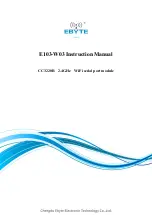
Chengdu Ebyte Electronic Technology Co., Ltd.
E103-W03 _User Manual _EN_V1.1
Copyright ©2012–2022, Chengdu Ebyte Electronic Technology Co., Ltd
.
11
5.3.4 MQTT
In the MQTT mode, the module supports Alibaba Cloud, Baidu Cloud, OneNet and other IoT platforms. Enter the service
parameters created on the platform into the module to communicate.
5.3.4.1 Alibaba Cloud
For network communication based on the Alibaba Cloud platform, you need to log in to Alibaba Cloud to obtain relevant
parameters, which mainly include product key, device name, client ID and other information. For details, see Chapter 7
Alibaba Cloud Configuration Tutorial.
5.3.4.2 Baidu Cloud
For network communication based on Baidu Cloud platform, you need to log in to Baidu Cloud to obtain relevant
parameters, mainly including device name, user name, password, etc. For details, see Chapter 7 Baidu Cloud
Configuration Tutorial.
5.3.4.3 Onenet
For network communication based on the OneNet cloud platform, you need to log in to OneNet to obtain relevant
parameters, mainly including device ID, product ID, authentication information, etc. For details, see Chapter 7 OneNet
Configuration Tutorial.
5.3.5 HTTP Client
When using this function, you only need to configure the corresponding server resource symbol URL, and start a trigger
request to obtain the resource that the server responds to. You don't need to care about the complicated HTTP protocol
layer. For details, see Chapter 6 HTTP Client Configuration Tutorial.
5.3.6 WebSocket
The traditional HTTP transmission protocol is based on access and response. In this way, the server is always passive and
cannot be applied to the application where the web client and the WEB server frequently interact. The application of the
WebSocket function allows the E103-W03 module to communicate through the serial port. Real-time interaction with the
webpage saves the GET and POST request process initiated by the HTTP client during multiple interactions, improves
the response speed, and the module side can actively push data to the webpage. See Chapter 7 WebSocket Configuration
Tutorial for details.















































